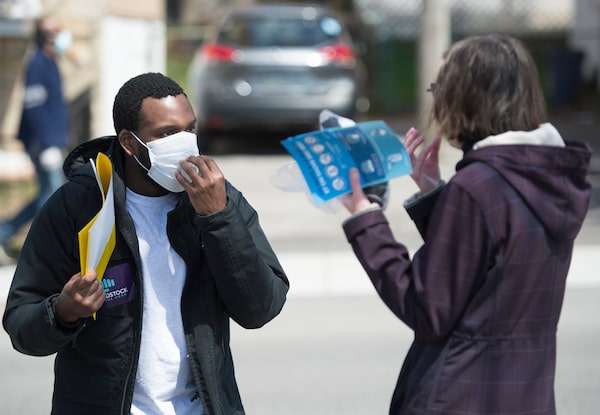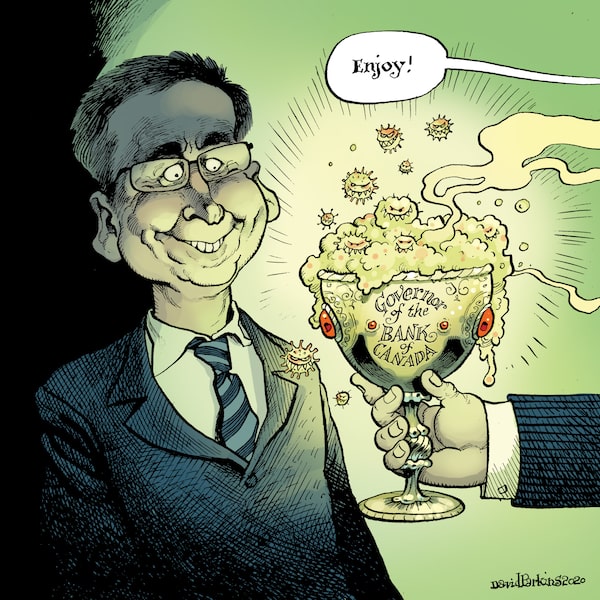Good morning,
Talks between Cargill Ltd. and the union representing its workers continued into the night Sunday as the company prepared to reopen its slaughterhouse in High River, Alta., the site of Canada’s largest COVID-19 outbreak.
By Sunday, 935 employees at the facility, which accounts for 36 per cent of the country’s beef production, had tested positive. One employee has died, Bui Thi Hiep. Workers will take part in an online tribute to her on Monday.
Cargill announced last week it would resume operations Monday. The union, in response, sought a stop-work order from Alberta Occupational Health and Safety (OHS) and filed an unfair labour practice complaint, naming Cargill and the provincial government as respondents.
This is the daily Morning Update newsletter. If you’re reading this on the web, or it was forwarded to you from someone else, you can sign up for Morning Update and more than 20 more Globe newsletters on our newsletter signup page.
Poll shows less than half of Canadians wear masks when out
With Canada’s economy starting to reopen, a new poll shows less than half of Canadians are wearing personal protective equipment when they go outside their homes.
According to the poll, conducted for The Globe and Mail, 57 per cent of respondents reported not wearing masks or gloves when they leave their home. Of those who do wear protective gear, 14 per cent report wearing both masks and gloves, 19 per cent say they wear just masks and 10 per cent stick with just gloves.

A volunteer, left, talks to a woman about how to place a mask on your face in Montreal North, Saturday, May 2, 2020, as the COVID-19 pandemic continues in Canada and around the world. THE CANADIAN PRESS/Graham HughesGraham Hughes/The Canadian Press
Canadian universities work to mitigate financial threat posed by coronavirus
In a whirlwind six weeks, Canadian universities redesigned their system of teaching and examination, and they supported their students through the financial shock of the pandemic. Now they’re reckoning with a changed world.
Governments in some provinces are looking to slash the institutions’ budgets. Some students are campaigning for tuition cuts or threatening to take a gap year rather than pay for a reduced university experience. International students, an important source of income, may not be able to get to Canada in September.
How will Canada’s universities survive?
Got a news tip that you’d like us to look into? E-mail us at tips@globeandmail.com Need to share documents securely? Reach out via SecureDrop
ALSO ON OUR RADAR
Hong Kong protesters seek refuge in Canada
Close to 50 Hong Kongers – many of whom took part in the massive demonstrations that began last year as China tightened its grip on the Asian city – are seeking asylum in Canada, citing harassment and brutality at the hands of police in the former British colony and fear of unjust prosecution.
Forty-six people with Hong Kong citizenship applied for asylum claims between Jan 1, 2019 and March 31, 2020, according to a source with knowledge of the matter. The claims, which are all pending, were received at airports, Canada Border Security Agency bureaus and Immigration, Refugee and Citizenship Canada offices (IRCC) across the country. The Globe and Mail is not identifying the source, who was not authorized to speak about the issue.
MORNING MARKETS
World stocks fall as U.S./China tensions threaten rebound: European stock markets and oil prices fell on Monday as a spat between top U.S. officials and China over the origin of the coronavirus fueled fears of a new trade war, derailing a rebound in global markets. In Europe, Germany’s DAX and France’s CAC 40 were down 3.88 per cent and 4.54 per cent, respectively. In Asia, Hong Kong’s Hang Seng fell. 4.18 per cent. New York futures were lower. The Canadian dollar was trading below 71 US cents.
Looking for investing ideas? Check out The Globe’s weekly digest of the latest insights and analysis from the pros, stock tips, portfolio strategies and what investors need to know for the week ahead. This week’s edition includes stocks to dump, a Buffett favourite number and haven plays in turbulent markets.
WHAT EVERYONE’S TALKING ABOUT
After almost two months of being told to “stay at home,” it’s time for a new mantra.
André Picard: “Before people start complaining officials are back-pedalling, let’s be clear about one thing: As the pandemic changes, so too must the public health and political messaging. The lockdown was appropriate, but never meant to be forever. The ‘stay at home’ rules were designed to slow the spread of coronavirus within communities so that hospitals would not be overwhelmed.”
Take this warning: the post-pandemic economic order will be be driven by geo-politics
Campbell Clark: “The rules that we thought applied to the global economy have been in tatters, but this pandemic is looking like an inflection point. Around the world, voices on the left and right are cheering on the end of that global liberal economic order. In Canada, a few thinkers who aren’t cheering are arguing that a transformation is more or less unstoppable – and we better figure out how to handle it.”
When there is nothing to watch, some people will watch anything
Cathal Kelly: “I’ve watched Taiwanese baseball and Belarusian soccer. I’ve watched Marbula One (the marble version of Formula 1) and professional tag (which is better than it sounds). I have watched a lot of chess. Like, a lot. But I don’t think I’ve watched anything as strange and compelling as this weekend’s virtual Kentucky Derby.The Derby was supposed to go off on Saturday. It’s been postponed until September. In order to fill the space where the Derby should have been, NBC broadcast an impostor Derby featuring animations of past winners racing each other."
TODAY’S EDITORIAL CARTOON

David ParkinsDavid Parkins/The Globe and Mail
LIVING BETTER
Running has never been so stress-relieving – and so fraught
Running etiquette has changed drastically in the era of coronavirus. Runners are getting the side-eye treatment on streets across Canada. They’re criticized on social media from those who believe runners pose a risk of spreading the coronavirus with their huffing and puffing.
If you’re set on getting in your miles, here are some perspectives and ways to do so while keeping everyone safe.
MOMENT IN TIME
Six of the Group of Seven artists, plus their friend Barker Fairley, sitting around table at the Arts and Letter Club in Toronto in 1920. From clockwise around the table, starting at the left: Frederick Varley, A. Y. Jackson, Lawren Harris, Barker Fairley, Frank Johnston [Francis Hans Johnston, known as Franz or Frank], Arthur Lismer, and J. E. H. MacDonald. Photo by Arthur Goss. Originally published August 27, 1960, Globe Magazine, page 42.Arthur Goss/Supplied
For more than 100 years, photographers have preserved an extraordinary collection of 20th-century news photography for The Globe and Mail. Every Monday, The Globe features one of these images. This month, we are looking at the Group of Seven, whose inaugural exhibition was 100 years ago.
This 100-year-old photograph shows six members of the Group of Seven at the Arts & Letters Club in Toronto around the time the group formed in 1920. From left, they are: Frederick Varley, A. Y. Jackson (in the foreground with arms on the table), Lawren Harris, Barker Fairley (a painter who was not a member), Frank Johnston, Arthur Lismer and J.E.H. MacDonald. Franklin Carmichael, the youngest of the original seven, is not present. The picture was taken by the city photographer Arthur Gross, better known for documenting poverty in Toronto.
The Arts & Letters Club, which still exists, was a gathering place for the artists where they could share their frustrations over the conservative environment of the day. Alone, the artists were often relegated to back corners in exhibitions of academic art and subject to reactionary reviews. Together, as a school dedicated to painting northern landscapes in styles inspired by Post-Impressionist European art, they proved successful at convincing Canadians their art was a dynamic national expression.
Johnston dropped out and was replaced by A.J. Casson in 1926, but the association lasted until MacDonald’s death in 1932, after which the artists formed the larger Canadian Group of Painters.
If you’d like to receive this newsletter by e-mail every weekday morning, go here to sign up. If you have any feedback, send us a note.